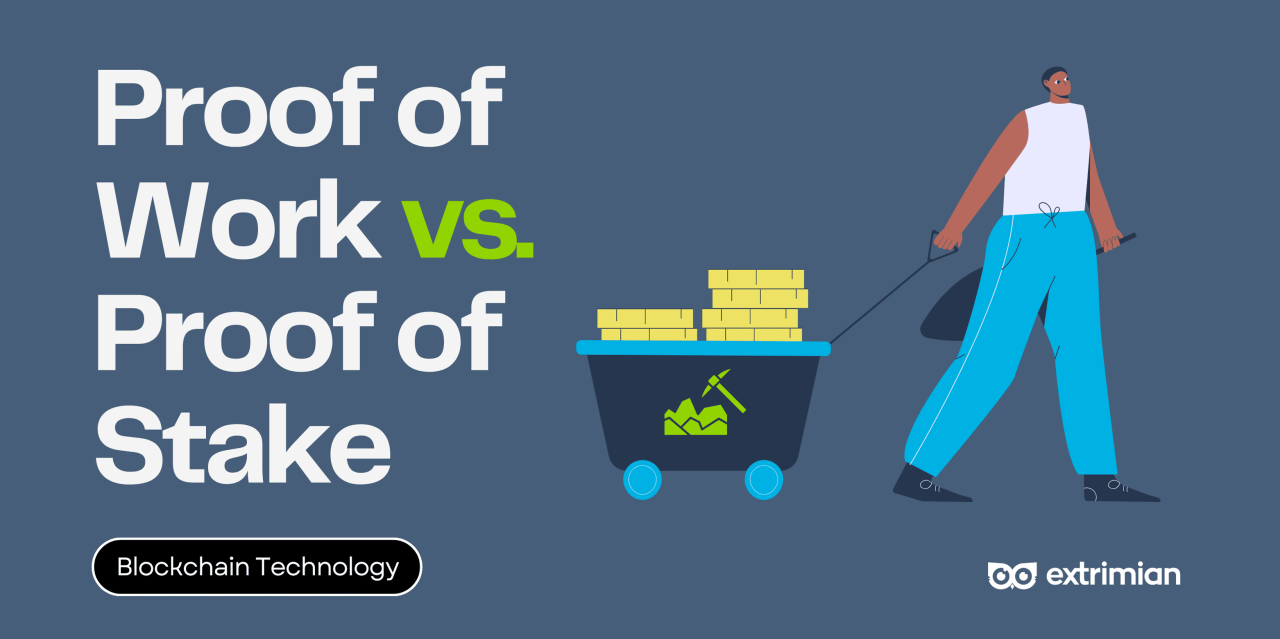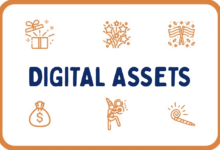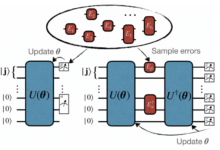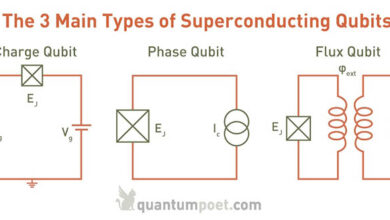Proof of stake vs proof of work A Comprehensive Comparison
Proof of stake vs proof of work: The debate surrounding these two fundamental blockchain consensus mechanisms is central to the ongoing evolution of cryptocurrency and decentralized technologies. This comparison delves into the core differences between these approaches, exploring their respective strengths and weaknesses across key areas such as energy consumption, security, scalability, and economic models. Understanding these distinctions is crucial for anyone navigating the complex landscape of blockchain technology.
From the environmental impact of massive energy consumption to the intricacies of transaction speeds and security vulnerabilities, we’ll examine how Proof-of-Work (PoW) and Proof-of-Stake (PoS) shape the functionality and future of various blockchain networks. We will analyze the economic incentives driving participation in each system, explore the governance models involved, and provide illustrative examples of prominent blockchains employing each mechanism.
This analysis aims to provide a clear and comprehensive understanding of the trade-offs inherent in each approach.
Energy Consumption Comparison
The choice between Proof-of-Work (PoW) and Proof-of-Stake (PoS) consensus mechanisms is significantly influenced by their vastly different energy consumption profiles. Understanding this difference is crucial for assessing the environmental impact and long-term sustainability of blockchain networks. This section will delve into a detailed comparison of energy usage, highlighting the key disparities and their implications.
Proof-of-Work, famously used by Bitcoin, requires miners to expend significant computational power to solve complex cryptographic puzzles. The winner gets to add the next block to the blockchain and receives a reward. This process is inherently energy-intensive, as miners compete in a race to solve these puzzles, consuming vast amounts of electricity. In contrast, Proof-of-Stake validators are selected based on their stake (the amount of cryptocurrency they hold).
This process requires far less computational power, resulting in drastically reduced energy consumption.
Energy Usage Per Transaction
The energy consumed per transaction varies significantly between PoW and PoS. In PoW systems, each transaction contributes to the overall energy consumption through the computational power needed for mining. The energy cost per transaction can fluctuate depending on network congestion and the difficulty of the cryptographic puzzles. For example, a Bitcoin transaction might consume energy equivalent to powering a household for several hours.
In contrast, PoS systems have a drastically lower energy footprint per transaction. The energy consumed is primarily related to the validator’s hardware and network communication, resulting in significantly lower energy consumption per transaction, potentially orders of magnitude less than PoW.
Estimated Annual Energy Consumption Comparison
The following table compares the estimated annual energy consumption of hypothetical blockchain networks using PoW and PoS, considering varying transaction volumes and hardware efficiency. These are estimations based on current trends and may vary depending on technological advancements and network growth.
| Consensus Mechanism | Annual Transactions | Average Transaction Energy Consumption (kWh) | Estimated Annual Energy Consumption (kWh) |
|---|---|---|---|
| Proof-of-Work | 100,000,000 | 1000 | 100,000,000,000 |
| Proof-of-Stake | 100,000,000 | 0.1 | 10,000,000 |
| Proof-of-Work | 1,000,000,000 | 750 | 750,000,000,000 |
| Proof-of-Stake | 1,000,000,000 | 0.05 | 50,000,000 |
Environmental Impact
The environmental impact of PoW and PoS differs dramatically. PoW systems, with their high energy consumption, contribute significantly to carbon emissions, especially if the electricity used is generated from fossil fuels. This contributes to climate change and air pollution. The Bitcoin network’s energy consumption has been compared to the energy consumption of entire countries. In contrast, PoS systems have a significantly smaller carbon footprint due to their lower energy needs.
The environmental impact is further reduced if the network relies on renewable energy sources for its operations. While PoS is not entirely carbon-neutral, its drastically lower energy consumption makes it significantly more environmentally friendly than PoW. The shift towards renewable energy sources within the cryptocurrency industry is further mitigating the environmental concerns associated with both PoW and PoS.
Security and Decentralization
Proof-of-Work (PoW) and Proof-of-Stake (PoS) differ significantly in their approaches to security and decentralization, impacting their resilience against attacks and the distribution of power within their networks. Understanding these differences is crucial for evaluating the long-term viability and robustness of each consensus mechanism.
Network Security Strengths and Weaknesses
PoW’s security stems from the significant computational power required to solve complex cryptographic puzzles. This high energy barrier makes it economically infeasible for attackers to control a majority of the network’s hash rate, thus preventing double-spending and fraudulent transactions. However, PoW’s reliance on massive energy consumption creates a vulnerability to attacks targeting mining farms through physical means, like power outages or coordinated attacks.
Furthermore, the concentration of mining power in large mining pools raises concerns about centralization, even though the underlying algorithm remains decentralized.In contrast, PoS relies on the economic stake of validators to secure the network. Validators who act maliciously risk losing their staked tokens, creating a strong incentive to behave honestly. This mechanism generally requires less energy than PoW, resulting in a lower environmental impact.
However, PoS networks are vulnerable to “nothing-at-stake” attacks, where validators can vote on multiple conflicting blocks without significant penalty, potentially leading to network instability. Furthermore, a sufficiently wealthy attacker could accumulate a large stake, potentially enabling them to exert significant influence or even control over the network. The potential for validator collusion also represents a security concern.
Decentralization Comparison
PoW systems, in theory, achieve a higher degree of decentralization because anyone with sufficient computational power can participate in mining. However, the high barrier to entry favors large mining operations and pools, leading to a concentration of power. This concentration can compromise the network’s decentralization, even though the underlying protocol remains theoretically decentralized. Factors influencing PoW decentralization include the cost of hardware, electricity prices, and the availability of skilled miners.PoS systems, while aiming for greater decentralization through reduced barriers to entry, can suffer from a different type of centralization.
The requirement to stake a significant amount of cryptocurrency can exclude smaller participants, leading to a concentration of power among wealthy individuals or entities. This can be mitigated by mechanisms like slashing penalties, which punish validators for malicious behavior, and by promoting a diverse validator set. Factors influencing PoS decentralization include the minimum stake requirement, the distribution of token holdings, and the effectiveness of mechanisms designed to prevent validator collusion.
Examples of Attacks and Defenses
A notable example of a successful attack against a PoW network was the 51% attack on Bitcoin Gold in 2018. Attackers gained control of more than half the network’s hash rate, allowing them to reverse transactions and steal cryptocurrency. Defenses against such attacks primarily involve increasing the computational power of the network and improving monitoring of hash rate distribution.In the PoS context, the “nothing-at-stake” vulnerability has been exploited in various attacks, although less dramatically than large-scale 51% attacks on PoW systems.
The defenses against these attacks generally involve improving consensus mechanisms to penalize validators who participate in conflicting blocks more severely and using mechanisms to detect and prevent collusion among validators. For instance, some PoS networks use sophisticated validator selection algorithms to ensure a diverse and representative set of validators.
Transaction Speed and Scalability
Proof-of-work (PoW) and proof-of-stake (PoS) consensus mechanisms differ significantly in their approaches to transaction processing, leading to variations in transaction speeds and the overall scalability of the blockchain networks they support. Understanding these differences is crucial for evaluating the suitability of a blockchain for specific applications.PoW blockchains, like Bitcoin, typically exhibit slower transaction speeds and lower throughput compared to PoS blockchains.
This is primarily due to the computationally intensive process of mining new blocks, which involves solving complex cryptographic puzzles. The time required to validate and add transactions to the blockchain is directly related to the block generation time. Conversely, PoS blockchains, such as Cardano or Solana, achieve faster transaction speeds because block creation is determined by the stake held by validators, eliminating the need for computationally expensive mining.
This allows for quicker transaction confirmation times and higher throughput.
Transaction Speed and Throughput Comparison
The transaction speed and throughput of PoW and PoS blockchains vary significantly. Bitcoin, a prominent PoW blockchain, processes an average of 7 transactions per second (TPS), while Ethereum, also using PoW (before the Merge), had a throughput in the range of 15-20 TPS. In contrast, PoS blockchains demonstrate considerably higher throughput. Solana, for instance, boasts a theoretical TPS of over 2,000, although actual throughput can vary depending on network conditions.
Cardano, another PoS blockchain, has a significantly lower but still higher than PoW TPS of approximately 250. These differences are primarily attributed to the fundamental differences in their consensus mechanisms.
Impact of Scaling Solutions
Various scaling solutions aim to enhance the performance of both PoW and PoS blockchains. Layer-2 scaling solutions, such as Lightning Network for Bitcoin and various rollup technologies for Ethereum, significantly improve transaction speeds and throughput by processing transactions off-chain before settling them on the main blockchain. These solutions are applicable to both PoW and PoS systems, although their implementation and effectiveness might vary.
Sharding, a technique that divides the blockchain into smaller, more manageable shards, is another scaling solution that can benefit both types of blockchains by distributing the workload across multiple nodes. However, sharding is more complex to implement and requires careful consideration of security and decentralization implications. For PoW systems, the computational intensity remains a significant bottleneck, even with scaling solutions, limiting the potential for drastic improvements.
PoS systems, being less computationally intensive, often demonstrate greater adaptability to various scaling solutions, leading to more substantial performance gains.
Transaction Fees and Confirmation Times
The following table summarizes the typical transaction fees and confirmation times for some popular blockchains utilizing PoW and PoS mechanisms. Note that these values are subject to network congestion and can fluctuate.
| Blockchain | Consensus Mechanism | Average Transaction Fee | Average Confirmation Time |
|---|---|---|---|
| Bitcoin | PoW | Variable, often $1 – $50+ | 10-60 minutes |
| Ethereum | PoS (Post-Merge) | Variable, often $0.10 – $5 | 12-15 seconds |
| Cardano | PoS | Low, often less than $0.10 | Few seconds to minutes |
| Solana | PoS | Very low, often less than $0.01 | Sub-second |
Staking and Mining Economics: Proof Of Stake Vs Proof Of Work
The economic incentives driving participation in both Proof-of-Work (PoW) and Proof-of-Stake (PoS) consensus mechanisms are fundamentally different, reflecting their contrasting approaches to securing the blockchain. PoW relies on computational power, rewarding miners for their energy expenditure, while PoS incentivizes participants to lock up their cryptocurrency, rewarding them for their contribution to network security. Understanding these incentives is crucial to grasping the operational and economic realities of each system.PoW and PoS systems offer distinct economic models for participants.
In PoW, miners invest in specialized hardware and electricity to solve complex cryptographic puzzles, earning block rewards and transaction fees. In PoS, validators stake their cryptocurrency, receiving rewards for validating transactions and proposing new blocks. The profitability of each depends on various factors, including hardware costs, energy prices, network hash rate, and cryptocurrency price.
Proof-of-Work Mining Hardware and Costs
The hardware used in PoW mining has evolved significantly. Early Bitcoin mining could be done with CPUs, but the increasing difficulty necessitated the use of specialized Application-Specific Integrated Circuits (ASICs). These ASICs are designed for a single purpose – solving cryptographic hash functions – and are far more efficient than general-purpose hardware like GPUs or CPUs. The cost of ASIC miners varies greatly depending on their hashing power and brand.
High-end ASICs can cost thousands of dollars, requiring substantial upfront investment. Beyond the initial hardware cost, significant ongoing expenses include electricity consumption (often substantial), cooling systems, and potential maintenance or repair. The lifespan of these machines is also a factor; ASICs can become obsolete relatively quickly as newer, more efficient models are released, leading to potential write-offs of older equipment.
For example, a high-end Antminer S19 XP can cost several thousand dollars, while its electricity consumption could easily exceed $100 per month depending on energy prices.
Return on Investment (ROI) Comparison: PoW Mining vs. PoS Staking
Comparing the ROI of PoW mining and PoS staking requires considering several variables. For PoW mining, factors such as the cost of ASICs, electricity costs, mining pool fees, the cryptocurrency’s price, and the network’s difficulty all influence profitability. A high network difficulty reduces the likelihood of finding a block, lowering the return. Conversely, a high cryptocurrency price increases the value of block rewards, improving ROI.
In PoS, ROI depends on the amount staked, the annual percentage yield (APY) offered by the network, and the cryptocurrency’s price. Higher staking amounts generally yield higher rewards, but the APY can fluctuate depending on network conditions and validator participation. Calculating a precise ROI for either requires careful analysis of real-time data and projecting future cryptocurrency prices and network parameters, a task fraught with uncertainty.For example, let’s consider a hypothetical scenario.
Assume an ASIC miner costing $5,000 with monthly electricity costs of $150 and an average monthly mining reward equivalent to $200. The net monthly profit would be $50, resulting in a relatively slow ROI. In contrast, a PoS system might offer a 10% annual APY on a staked amount of $5,000. This would yield $500 annually, or $41.67 monthly, a potentially faster ROI.
However, the cryptocurrency’s price volatility and potential changes in the APY significantly impact the long-term profitability of both approaches. These are simplified examples; real-world calculations necessitate detailed, up-to-date data.
Governance and Community Participation
Proof-of-Work (PoW) and Proof-of-Stake (PoS) blockchains differ significantly in their governance structures and how community members participate in decision-making. Understanding these differences is crucial for evaluating the long-term sustainability and resilience of each system. This section explores the governance models, upgrade mechanisms, and potential for centralization within each.PoW and PoS systems employ distinct approaches to governance, impacting community involvement and the potential for influence by powerful stakeholders.
The distribution of power and the mechanisms for protocol upgrades are key aspects influencing the overall health and adaptability of these blockchain networks.
Governance Models in PoW and PoS
PoW systems, like Bitcoin, often lack a formal governance structure. Community participation typically occurs through informal channels such as forums, social media, and dedicated developer communities. Major decisions, such as protocol upgrades, often rely on consensus among developers and miners, with the latter wielding significant influence due to their computational power. This can lead to debates and disagreements, potentially slowing down the upgrade process.
In contrast, PoS systems frequently incorporate more formalized governance mechanisms. These may involve token holders voting on proposals, with the weight of their vote proportional to their stake. Examples include systems using on-chain governance proposals or employing dedicated governance tokens. This structured approach can enhance community involvement and streamline decision-making, but it can also create new challenges regarding the fair representation of all stakeholders.
Protocol Upgrade Mechanisms
In PoW systems, protocol upgrades often require a high degree of consensus among miners. This can be a slow and challenging process, especially when dealing with contentious issues. A significant portion of the mining community must agree to implement the upgrade for it to be successfully integrated into the network. Failure to reach consensus can lead to network forks, resulting in competing blockchain versions.
PoS systems generally offer more streamlined upgrade processes. Depending on the specific design, upgrades might require a majority vote from token holders or a designated group of validators. This can make the process faster and more efficient, but it also raises concerns about the potential for manipulation by large stakeholders. For example, a significant token holder could potentially influence the outcome of a vote.
Centralization and Influence of Large Stakeholders
The potential for centralization is a concern for both PoW and PoS systems. In PoW, the concentration of mining power in the hands of a few large mining pools poses a risk. This concentration could potentially allow these pools to exert undue influence over the network, potentially censoring transactions or manipulating the blockchain. While PoS aims to distribute power more widely, the risk of centralization remains.
Large token holders could potentially exert significant influence over governance decisions and network operations. The potential for “whale” manipulation, where a single large holder controls a substantial portion of the staked tokens, is a key concern. The design of the PoS system, specifically the token distribution and the rules governing staking, significantly impacts the likelihood of such centralization.
For instance, systems with a high degree of token concentration are inherently more vulnerable. Conversely, those with more decentralized token distribution are better positioned to resist the influence of large stakeholders.
Illustrative Examples of Blockchains
This section provides detailed examples of prominent blockchains employing both Proof-of-Work (PoW) and Proof-of-Stake (PoS) consensus mechanisms. Understanding these specific implementations illuminates the practical applications and inherent strengths and weaknesses of each approach. We will examine their unique features and compare their performance characteristics.
Proof-of-Work Blockchains
The following examples showcase the diversity within PoW blockchains, highlighting their differing approaches to security and scalability.
Bitcoin
Bitcoin, the pioneering cryptocurrency, utilizes a PoW consensus mechanism based on cryptographic hashing. Miners compete to solve complex mathematical problems, and the first to find the solution adds a new block to the blockchain and receives a reward in Bitcoin. This process ensures the security and integrity of the network through its distributed nature and computational difficulty.
- Advantages: Highly secure due to its decentralized and computationally intensive nature; established network effect and wide adoption; relatively transparent and auditable transaction history.
- Disadvantages: High energy consumption; slow transaction speeds; scalability limitations; susceptibility to 51% attacks (though highly improbable given the network’s size).
Ethereum (Pre-Merge)
Before the Merge in September 2022, Ethereum employed a PoW mechanism similar to Bitcoin, relying on miners to validate transactions. However, Ethereum’s smart contract functionality introduced greater complexity and transaction diversity compared to Bitcoin’s simpler design.
- Advantages: Supports smart contracts and decentralized applications (dApps); large and active developer community; relatively robust network.
- Disadvantages: High energy consumption; transaction fees (gas) can be volatile and expensive; scalability challenges before the Merge.
Litecoin, Proof of stake vs proof of work
Litecoin is a cryptocurrency designed to be a faster and more efficient alternative to Bitcoin. While also using PoW, it employs a different hashing algorithm (Scrypt) and has a shorter block time, resulting in quicker transaction confirmations.
- Advantages: Faster transaction speeds than Bitcoin; lower transaction fees compared to Bitcoin; stronger privacy features compared to Bitcoin.
- Disadvantages: Still relatively energy-intensive compared to PoS blockchains; smaller network effect than Bitcoin; susceptible to the same general vulnerabilities as other PoW systems.
Proof-of-Stake Blockchains
These examples illustrate the variety in PoS implementations and their attempts to address the limitations of PoW.
Cardano
Cardano uses a unique, layered architecture and a PoS consensus mechanism called Ouroboros. This mechanism involves delegating staking rights to stake pools, which validate transactions and add blocks to the blockchain. The system prioritizes scientific peer review and rigorous development processes.
- Advantages: Energy-efficient; high throughput potential; focus on formal verification and security; strong academic foundation.
- Disadvantages: Relatively new compared to other established blockchains; complex architecture can be challenging for some users; potential for centralization if stake pools become overly concentrated.
Solana
Solana employs a novel hybrid consensus mechanism combining PoH (Proof-of-History) with PoS. PoH provides a verifiable timestamping mechanism, improving transaction throughput and reducing latency. Stakeholders validate transactions and earn rewards.
- Advantages: High transaction speeds and scalability; low transaction fees; innovative consensus mechanism.
- Disadvantages: Centralization concerns due to its unique architecture and validator distribution; has experienced network outages in the past; relatively young and less mature ecosystem compared to Ethereum.
Cosmos
Cosmos is a network of interconnected blockchains, each with its own independent PoS mechanism. This allows for interoperability between different blockchains within the Cosmos ecosystem. It uses Tendermint consensus, a variant of PoS.
- Advantages: Interoperability between different blockchains; flexible and scalable architecture; relatively low energy consumption.
- Disadvantages: Complexity of the inter-blockchain communication system; potential for security vulnerabilities across the interconnected network; relatively new and still under development.
Closing Notes

Source: extrimian.io
Ultimately, the choice between Proof-of-Work and Proof-of-Stake hinges on the specific priorities of a given blockchain network. While PoW offers robust security through its energy-intensive process, PoS prioritizes efficiency and scalability with reduced environmental impact. The ongoing development and refinement of both mechanisms suggest that neither approach is inherently superior, and the optimal choice will likely continue to evolve as the blockchain landscape matures and adapts to new challenges and opportunities.
Helpful Answers
What are the potential downsides of Proof-of-Stake?
While PoS offers numerous advantages, potential downsides include the risk of “nothing-at-stake” attacks, where validators might vote for multiple blocks simultaneously, and the potential for centralization if a small number of large stakeholders control a significant portion of the staked tokens.
Can Proof-of-Work be made more energy-efficient?
Research into more energy-efficient hardware and algorithms for PoW is ongoing. However, the fundamental energy-intensive nature of the consensus mechanism remains a significant challenge.
How does the governance model affect the long-term viability of a blockchain?
A well-designed governance model fosters community participation, promotes transparency, and ensures the long-term sustainability and adaptability of a blockchain network. Poor governance can lead to centralization, conflicts, and ultimately, the decline of the network.
What are some emerging consensus mechanisms beyond PoW and PoS?
Several alternative consensus mechanisms are being explored, including Delegated Proof-of-Stake (DPoS), Practical Byzantine Fault Tolerance (PBFT), and various hybrid approaches that aim to combine the strengths of PoW and PoS while mitigating their weaknesses.









